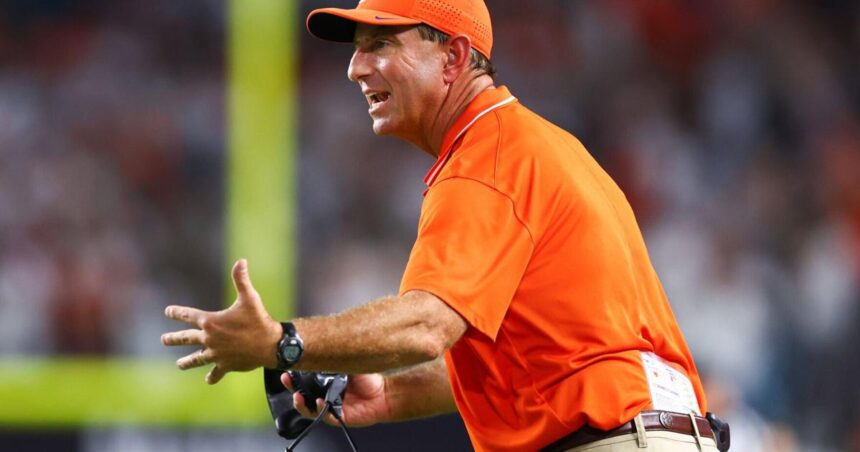CHARLOTTE, N.C. — Dabo Swinney has often said that he didn’t get a chance to join the Alabama football team as a walk-on wide receiver in 1990s, he wouldn’t be where he is today.
So Clemson’s two-time national champion football coach, understandably, had a strong reaction to the recent news that walk-on players will be functionally eliminated amid new roster changes stemming from a court settlement.
“It’s a really sad thing to me,” Swinney said Thursday during ACC Kickoff.
According to various reports, the power conference commissioners (including ACC commissioner Jim Phillips) have agreed to move from a “scholarship limit” setup to a “roster limit” setup starting in 2025-26 as part of a settlement in the House vs. NCAA court case, which is expected to be approved Friday, per The Athletic.
That settlement will clear the way for colleges to share roughly $20 million in revenue apiece with their student-athletes (each school has the discretion to split that money up as it pleases among athletes in various sports).
People are also reading…
But the settlement also means one big change for college football rosters. Previously, teams such as Clemson were limited to giving out 85 full scholarships to players — but they could also have up to 120 total players on their roster, including walk-ons.
Under the new setup for 2025 and beyond, college football programs will no longer be limited to how many scholarships they can offer. They’ll be limited in total roster size — with each player on that roster (up to 105) receiving a full scholarship.
“That’s great for baseball, soccer and some of the sports where you take 11 scholarships and spread it out amongst 30-some guys,” Swinney said. “But for football, the unintended consequence is it basically eliminates your walk-ons. There’s no coach that wants that.”
Speaking from the Hilton Uptown Charlotte during the ACC’s annual football media days, Swinney gave a passionate, in-depth response on the value of walk-ons that lasted over six minutes and took up nearly half of his time at the podium.
“I don’t think there was an intention to say, ‘OK, you can have no more walk-ons,’ Swinney said. “I think the way it was settled: Whatever your roster size is, that’s your scholarship limit. So you couldn’t limit scholarships.”
“That’s where administrators get together and say, ‘We can’t have 130 guys on scholarship, so we’re going to have to reduce the roster.’ Whatever they reduce it to, everybody has to be on scholarship. That’s how we’ve gotten to the situation.”
Clemson, for years under Swinney, has maintained a robust walk-on presence on its roster. Sometimes, players such as wide receiver Hunter Renfrow catch on, earn a scholarship and become a star. Others become special teams contributors. Some never appear in a game but, Swinney said, make critical contributions from a depth and scout team perspective in practice.
“It’s frustrating,” Swinney said, referencing the newly expanded 12-team College Football Playoff. “We’re going to play more games than we’ve ever played, practice more than we ever played, finish (later in the year) than we ever (have), and have the smallest roster we’ve ever had.”
Swinney expressed concerns about how the elimination of walk-ons could affect teams’ depth. For any given NFL team, he said, a team has a set active roster of 53 and up to 16 practice squad players and that number “never changes” since teams can supplement their roster to offset injuries via free agent acquisitions.
In college, though, “you can’t grab the guy out of the algebra class in the middle of the season and bring him over here and plug him in.”
Swinney also said losing walk-ons is “frustrating” because Clemson needs to be “incredibly efficient” with its 17 weekly hours of practice time during the season and heavily relies on walk-ons to fill out their scout teams and give starting players fresh looks at opposing offenses and defenses.
“When you do away with the walk-ons — guys that are just wanting to be a part of it, that want to serve —that 105 is going to dwindle,” Swinney said, citing possible roster attrition from injuries as well as transfers. “There were teams last year that played bowl games, if this rule is in effect last year, they would have had to forfeit the bowl game because they wouldn’t have had enough players.”
Swinney also said he expects transfer portal rates to go “way up” under the new system, since the ACC currently limits travel rosters for road conference and non-conference games to 80. Previously, that meant anywhere from five to 10 scholarship players would not make road trips; now that number could jump to 20 to 25.
“That will be a lot of football players not getting to play,” Swinney said.





